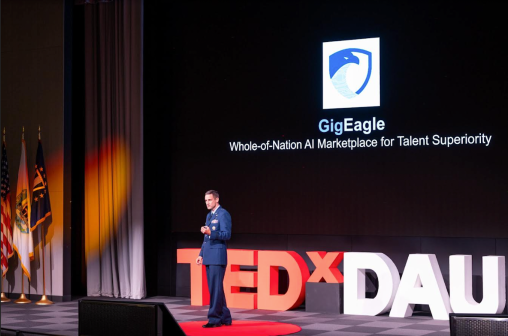Air Force CDAO looks to upskill workforce to meet AI readiness goals

As it strives to become data- and AI-ready by 2025, the Department of the Air Force’s Chief Data and Artificial Intelligence Office is focused on attracting, training and retaining the highly skilled workforce necessary to achieve its goal.
“It really comes down to your talent. We’re in a fierce competition for talent, we’re competing with all of our industry partners for great talent,” Department of the Air Force CDAO Eileen Vidrine said Wednesday during a keynote at Microsoft’s Federal Innovation Series, hosted by FedScoop. “I like to say with the team, ‘Mission first, but people always.’ And really, to drive that forward we have to make sure that we’re making targeted investments that have great return on investment.”
The department’s goal for AI readiness is part of a broader effort across the Pentagon to better harness data and improve the services’ capabilities in order to compete with U.S. adversaries. Once it achieves AI readiness, the Department of the Air Force then will work towards becoming “AI competitive” in operations by 2027.
The Air and Space Forces are already moving to bolster education and training in AI and data-centric skills, Vidrine noted. She pointed to programs at the United States Air Force Academy that allow cadets to major in data science — a relatively new initiative that Vidrine said will be “game-changing” in the long term — as well as postgraduate degree opportunities in data analytics at the Air Force Institute of Technology.
The department is also seeking external partnerships with industry and academia to upskill its employees, such as the AI Accelerator program at MIT “where our airmen and guardians work side by side doing research with some of our nation’s top AI researchers,” Vidrine said.
However, she emphasized the growing importance of attracting and retaining new talent in a creative way that is accommodating to the industry’s diverse pool of candidates. That includes “data talent pipelines” that bring people with know-how to the Department of the Air Force through internships and pathways for recent college graduates.
“We have a multi-generational workforce, so one size does not fit all,” she said. “We have to make sure that we have the right opportunities for each and everybody in our workforce.”
Vidrine highlighted a direct-hire authority — granted to federal agencies experiencing a shortage of workforce candidates — signed by the Office of Personnel Management on Sept. 29 that will allow the Department of the Air Force to streamline hiring of data scientists, specifically.
“That was great work by many people across the enterprise recognizing that we need that talent now, and we have to accelerate that change,” she said.






